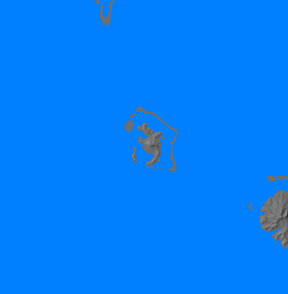![]() The Pacific War Online Encyclopedia
The Pacific War Online Encyclopedia
|
| Previous: Boomerang, Australian Fighter | Table of Contents | Next: Borneo |
 |
|
Bora Bora (151.752W
16.507S) is an island in the Society
Islands group in French
Polynesia, 140 miles (225 km) northwest of Tahiti, 2700 miles (4350 km)
south-southeast of Pearl Harbor,
and 1420 miles (2290 km) east of American Samoa.
The island is surrounded by a barrier reef
some 8 miles north to south
and 6 miles east to west. This reef is very wide to the south and west
and is rimmed with barrier islands to the east, north, and northwest.
There is only one pass through the reef, Teavanui Pass to the west, but
this is deep and leads directly into the excellent natural anchorage of Teavanui Harbor southwest
of the central island. This is protected to seaward by hilly Tupua
Island. A second smaller anchorage is located at Fanui Bay on the
northwest coast of the central island. The climate is pleasant at about
80F (27C) year-round with moderate precipitation. These features made
the island a good site for a naval base, the one significant liability
being a shortage of fresh water. However, there was not a single pier
in the harbor when war broke out.
The U.S. Navy
began developing a refueling station here even before the outbreak of
war. On December 30, 1941, following the attack on Pearl
Harbor,
the
island was identified as a strategic point along the sea lanes to Australia, and on 4 January 1942 the first orders for Operation BOBCAT were issued. Task Force 5614 with six transports and cargo ships sailed on 27 January and arrived on February 17, landing 4400 men from 102 Regiment
(minus a battalion), 198
Coast Artillery Regiment (Antiaircraft), and 1
Naval Construction Battalion
with 20,000 tons of supplies on the
island. Such rapid organization of the expedition was possible only
because most of the men and equipment in the expedition were already
earmarked for a program to set up naval bases in Britain. This first
attempt at a significant overseas expedition took 52 days to unload but
taught the U.S. services many lessons in logistics,
such as the need for adequate cargo nets and slings for unloading at
undeveloped ports and the need for proper loading of cargo ships. There were also difficulties with provisions for fresh water and in the command arrangements.
Eventually the garrison had 8 155mm coastal defense guns, and by early 1943 an airfield and aircraft assembly facility with a 5000' (1520 meter) runway was constructed on Motu Maue on the northern tip of the ring of barrier islands. However, the Allied victory at Midway ensured that the Japanese would never seriously threaten the island.
References
Carter
(1953)
Leighton and
Coakley (1955)
The Pacific War Online Encyclopedia © 2007, 2010, 2013 by Kent G. Budge. Index